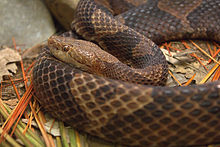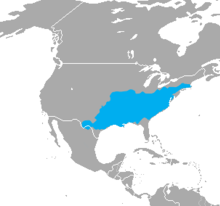Agkistrodon contortrix
| Agkistrodon contortrix | |
|---|---|
 |
|
| Scientific classification | |
| Kingdom: | Animalia |
| Phylum: | Chordata |
| Class: | Reptilia |
| Order: | Squamata |
| Suborder: | Serpentes |
| Family: | Viperidae |
| Genus: | Agkistrodon |
| Species: | A. contortrix |
| Binomial name | |
|
Agkistrodon contortrix (Linnaeus, 1766) |
|
 |
|
| Synonyms | |
|
|
Agkistrodon contortrix is a species of venomous snake endemic to Eastern North America, a member of the Crotalinae (pit viper) subfamily. The common name for this species is the Copperhead. The behavior of Agkistrodon contortrix may lead to accidental encounters with humans. Five subspecies are currently recognized, including the nominate subspecies described here.
Adults grow to an average length (including tail) of 50–95 cm (20–37 in). Some may exceed 1 m (3.3 ft), although that is exceptional for this species. Males are usually larger than females. Good-sized adult males usually do not exceed 74 to 76 cm (29 to 30 in), and females typically do not exceed 60 to 66 cm (24 to 26 in). In one study, males were found to weigh from 101.5 to 343 g (3.58 to 12.10 oz), with a mean of roughly 197.4 g (6.96 oz). According to a different study, females have a mean body mass of 119.8 g (4.23 oz). The maximum length reported for this species is 134.6 cm (53.0 in) for A. c. mokasen (Ditmars, 1931). Brimley (1944) mentions a specimen of A. c. mokasen from Chapel Hill, North Carolina, that was "four feet, six inches" (137.2 cm), but this may have been an approximation. The maximum length for A. c. contortrix is 132.1 cm (52.0 in) (Conant, 1958).
The body is relatively stout and the head is broad and distinct from the neck. Because the snout slopes down and back, it appears less blunt than that of the cottonmouth, A. piscivorus. Consequently, the top of the head extends further forward than the mouth.
The scalation includes 21–25 (usually 23) rows of dorsal scales at midbody, 138–157 ventral scales in both sexes and 38–62/37–57 subcaudal scales in males/females. The subcaudals are usually single, but the percentage thereof decreases clinally from the northeast, where about 80% are undivided, to the southwest of the geographic range where as little as 50% may be undivided. On the head there are usually 9 large symmetrical plates, 6–10 (usually 8) supralabial scales and 8–13 (usually 10) sublabial scales.
...
Wikipedia

